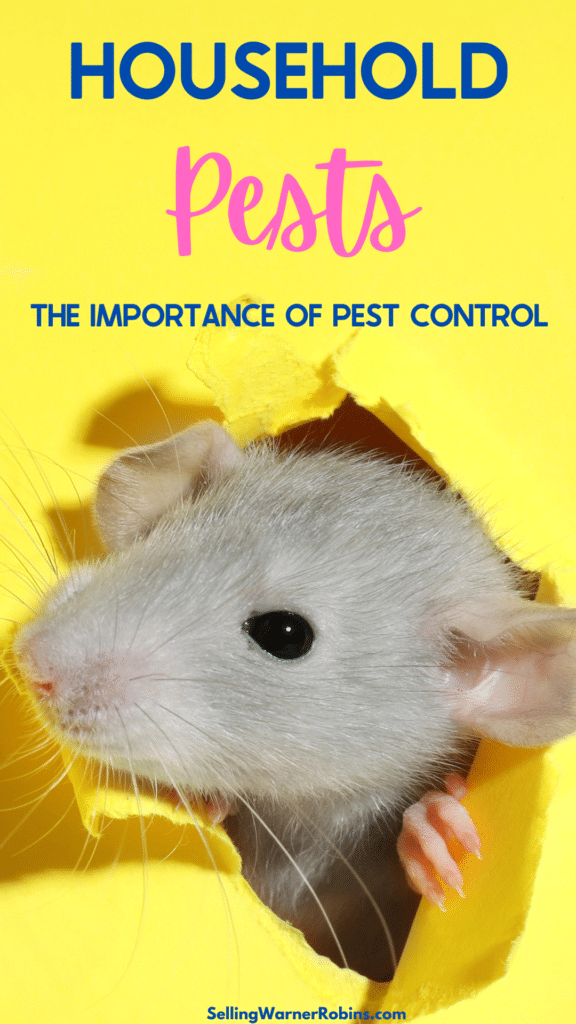Combatting Common Household Pests: 6 Types of Pests and Tips for Prevention
Think about this: a cozy, clean home with a fresh coat of paint, white picket fences, the greenest of grass, with every corner nary a speck of dust. Sounds like your dream home? You are not alone. While thoughts of utopia are blissful, reality says most homeowners will be combatting common household pests at some point. Best to touch on those issues and concerns now…
Behind most homes lurk hidden nuisances, critters that sneak in unnoticed, threatening to turn any dream home into a house straight from a nightmare. Most people think that the appeal of a home lies in its more noticeable aspects: the rooms, walls, roof, furniture, and so on. But it is often the small things that we don’t notice (or choose not to) that affect the house’s appeal.
That is where pest control steps in, not only keeping the creeps and crawls at bay but also boosting your home’s value. And if you are selling, a pest-free home is a big plus. It shows buyers that you have taken good care of the place, making it a more attractive buy. So, let us dig into the most common household pests and the importance of pest control in maintaining a clean (and valuable!) home.

Common Home Pests
Protecting your home from pests is hard work but can be mitigated with a sound plan. Here are some of the most common household pests you have or will encounter in your house:
Cockroaches
Cockroaches can wreak havoc in your home, not by eating through wood or metal but by infesting places like under cabinets, in basements, or inside electronics. They particularly damage softer areas like insulation and furniture and can mess with your electrical outlets. While they don’t directly damage sturdy materials like metal, their presence in heating ducts and drains can lead to contamination and worsen blockages.
Cockroach presence indicates unsanitary conditions. They carry proteins in their feces, saliva, and body parts that can trigger allergic reactions and asthma, especially in children. Studies have shown that exposure to cockroach allergens can lead to more frequent asthma attacks, hospitalizations, and missed school days. Moreover, cockroaches can spread various bacteria and pathogens, including staphylococcus, streptococcus, and salmonella, and can worsen respiratory diseases.
Mice and Rats
Mice can damage structures through gnawing and nest-building. They can damage insulation, electrical appliances, and even stored items like books and heirlooms. Mice are also a health concern as they can spread diseases like salmonellosis, leptospirosis, and lymphocytic choriomeningitis as well as contaminate food sources.
Similar to mice, rats are known to spread over 35 diseases. These can be transmitted directly through contact with rats or indirectly through fleas, ticks, or mites. Common diseases associated with rats include hantavirus, which can cause serious respiratory problems, lymphocytic choriomeningitis, and the plague.
Both pests invade homes seeking shelter and can damage insulation, electrical wiring, and personal items while building nests. This often hidden damage can be a costly surprise during home sales, sometimes resulting in properties selling for significantly less. They’re also challenging to eradicate once established, leading to ongoing maintenance and pest control costs.
Beyond the immediate structural damage caused by pests like termites and rodents, there’s a long-term financial impact to consider. Pests can also diminish a home’s marketability and appeal. When potential buyers see signs of infestations, whether through visible damage or reports of past issues, they may view the property as less desirable. Homes with pest problems are often subject to lower offers, or in the worst case, buyers might back out of the deal altogether. Additionally, the cost of repairing damage caused by pests can be significant, and insurance may not cover all of it. Early pest control not only saves you money in repairs but also preserves the value of your home, ensuring it remains a competitive option in the real estate market.
Termites
Termites, particularly notorious for their appetite for wood, pose a major threat to homes by feeding on cellulose in wooden structures, drywall, and paper, leading to significant structural damage. This can reduce a home’s resale value by about 20%. Termites often go unnoticed until substantial damage occurs, which can look similar to water damage, complicating early detection.
While termites are less known for carrying diseases, their presence can still pose health risks. Termite bites can lead to infections, and they can trigger allergies and asthma. In more severe cases, they are associated with respiratory illnesses, the plague, and typhoid. These health concerns, coupled with the need for homeowners to disclose termite infestations to potential buyers, can significantly lower a home’s market value.
Water damage and mold growth are often linked to pest problems, particularly when pests like rodents and termites invade homes. Mice and rats are notorious for seeking out water sources, and in their quest for hydration, they may chew through plumbing lines or cause leaks in walls or ceilings. Over time, this water damage can lead to the growth of mold, which is a significant health risk and a costly issue to repair.
Termites, which thrive in damp environments, are often drawn to areas with existing moisture problems, such as leaks from pipes or roofing. This creates a perfect storm for not only pest damage but also mold growth, which exacerbates air quality issues and further threatens the structural integrity of the home. They are one of the most destructive common household pests you may encounter, so know what signs to look for!
Silverfish and Moths
Silverfish, while harmless to humans in terms of bites or disease transmission, can still devalue your home through property damage and potential health concerns. They damage a variety of household items, such as wallpaper, clothing, upholstery, and even drywall, by chewing through them. Additionally, they can contaminate food sources and, in some cases, trigger allergic reactions in people, particularly those with conditions like asthma.
Moths, on the other hand, are another concern. Their larvae feast on fabrics like wool and cashmere and pantry items such as grains and pasta. Although moths don’t typically bite or sting, some species carry diseases like typhus and cholera, and contact with their larvae can cause skin irritations and allergic reactions.
Ants
Ants can cause serious structural damage. Particularly problematic are carpenter ants, which burrow into wood to create nesting sites, potentially compromising the structural integrity of a house. Ants can also damage house foundations by chewing through materials like concrete and drywall. They pose a threat to various parts of a home, including wiring, insulation, and wooden elements like doors and windows.
Moreover, ants present indirect health risks by carrying germs into homes. While they don’t carry diseases themselves, they can transfer harmful bacteria from contaminated areas to food supplies. This includes bacteria such as salmonella, escherichia coli, and shigella, leading to potential digestive system issues.
Fleas
Fleas can deter potential buyers, as these pests imply an unclean and unsanitary environment. Moreover, the cost and effort required to eradicate a flea infestation further diminishes a home’s value. Buyers noticing signs such as flea bites or visible infestations may view the property as less valuable, impacting its marketability.
Fleas also pose various health risks and can cause physical damage to the property, especially when fleas are most active. They do not harm the structure but can damage furniture and upholstery by laying eggs and leaving larvae that feed on organic matter. This results in the deterioration of furniture and causes stains and odors on carpets and bedding. Fleas can cause itching, irritation, and allergic reactions in humans and pets. They can transmit diseases like bartonellosis and murine typhus and carry pathogens leading to severe conditions like the plague and tapeworms.
Living with pests can have a significant emotional and psychological toll. The mere presence of pests in your home can cause anxiety and stress, as people often feel unsettled in their living spaces when dealing with infestations. The constant worry about health risks and potential property damage can lead to sleep disturbances, increased stress levels, and even depression. Children and elderly individuals, in particular, are vulnerable to these emotional impacts, and their sense of security in the home can be deeply affected. Pest-related stress can also interfere with daily routines, as family members might avoid certain areas of the home or spend excessive time trying to manage the issue themselves.
The Importance of Regular Pest Control

Let us start with something we all care about: our health. Regular pest control is more than just a tidying-up routine. It’s your front-line defense against health risks. Pests like rodents and cockroaches aren’t just icky; they’re carriers of diseases. Think about asthma, allergies, and even more serious diseases like salmonella. The CDC emphasizes the importance of managing these pests to minimize the risk of diseases they might carry. Good pest control services can help ensure these risks are kept at bay in your home.
Now, let’s talk money. Dealing with pests once they’ve already caused damage? That’s an expensive and stressful ordeal. Proactive pest control is a smart money move. It helps prevent damage to your home by those pesky pests–like rodents that chew through wires and furnishings. Getting ahead of the problem means you’re only spending on prevention, not on costly repairs and replacements later, saving you both time and money in the long run. A small investment now can prevent major expenses down the road, keeping your home safe and your budget intact.
Early Pest Detection Prevents Extensive Damage
Catching pests early is key. If you let them get too cozy, getting rid of them becomes a much bigger challenge. Early detection, especially through regular pest inspections, means you can nip potential infestations in the bud. The EPA backs this up, highlighting how crucial early detection and intervention are in pest management.
Some pests, like termites and carpenter ants, are not just nuisances—they’re home wreckers. They can cause severe structural damage if they’re not dealt with quickly. Regular pest inspections help identify these destructive creatures early, allowing for timely treatment. This early intervention can save you from costly structural repairs down the line. Remember, termites alone are responsible for billions in property damage every year in the US.
5 Best Measures and Practices to Prevent Pests
Pest control involves several practical steps, with a focus on creating an environment that’s less attractive to pests and more conducive to cleanliness and order. Here’s a more detailed look at these steps:
Screen and seal openings. Fit screens on doors, windows, and ventilation openings. Regularly inspect and repair these screens to prevent pests from entering. Install door sweeps or thresholds at the base of all exterior entry doors, and ensure no light penetrates underneath. Seal utility openings where pipes and wires enter the building, and repair any leaky pipes to reduce water availability.
Manage outdoor spaces. Regularly clean your yard, like leaves and grass clippings. Prune shrubs and tree limbs touching the house to eliminate potential entry points for pests. Use pest-resistant trash receptacles with self-closing lids and a tight seal.
Properly maintain your compost bin—avoid composting materials that attract pests like meats or fatty foods. Encourage natural pest predators like birds and bats by providing suitable habitats.
Protect Indoor practices from pests. Ensure food is covered and clutter is minimized. Avoid storing wood near your home, as it can be a habitat for pests. Cap your chimney to prevent pest entry. Tightly seal garbage cans and avoid using excessive fragrances outdoors, which can attract insects.
Diverse planting and maintenance. In your garden, plant a variety of plants, including perennials, annuals, and shrubs, to make it harder for pests to find their preferred host plants. Avoid overfeeding plants, as aphids are attracted to soft growth resulting from excessive fertilization.
Effective waste management. Properly manage waste by keeping garbage cans covered and sealed tightly. Dispose of food scraps in sealed containers or compost bins, and regularly empty your garbage to prevent it from becoming a breeding ground for pests. Clean up spills and messes promptly to avoid attracting pests. In cases where these measures are not enough, consider hiring a professional pest control company.
Final Household Pest Discussion
Enhancing your home’s value through effective pest control is about much more than just eliminating unwanted guests—it’s a comprehensive approach to creating a healthier, safer living environment.
Proper pest control contributes to a home that is visually appealing structurally sound and free from health risks associated with pests, making it a fantastic deal for anyone looking for a new home.
If you found this article on combatting common household pests: 6 types and tips for prevention of pests helpful, please consider sharing it so more consumers can benefit from the information.
Fighting Common Household Pests: 6 Types and Tips for Pest Prevention
About Anita Clark Realtor
Anita Clark has written 687 posts on this blog.
by Anita Clark Anita is a residential Real Estate Agent in Warner Robins Georgia, with Coldwell Banker Access Realty (478) 953-8595, aiding buyers and sellers with all their real estate questions on her Warner Robins blog.



